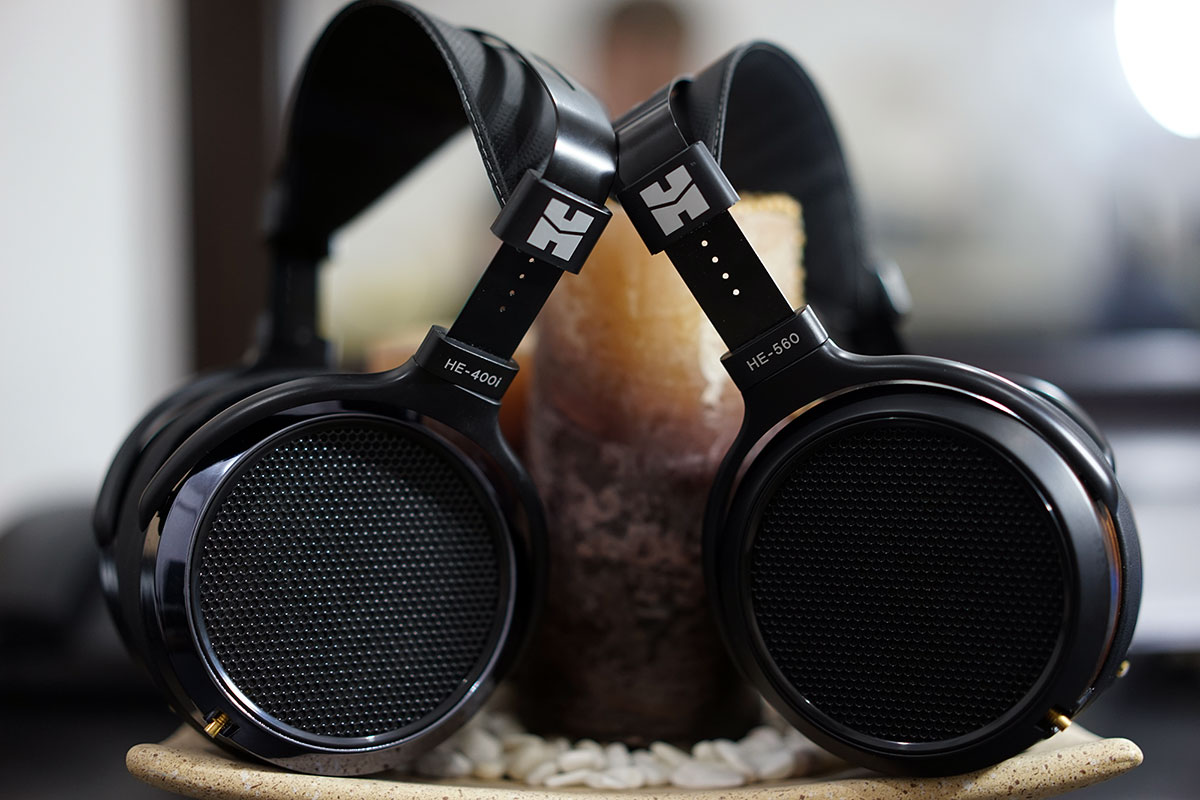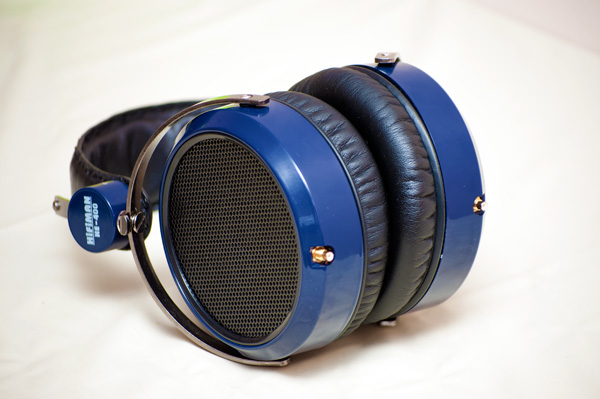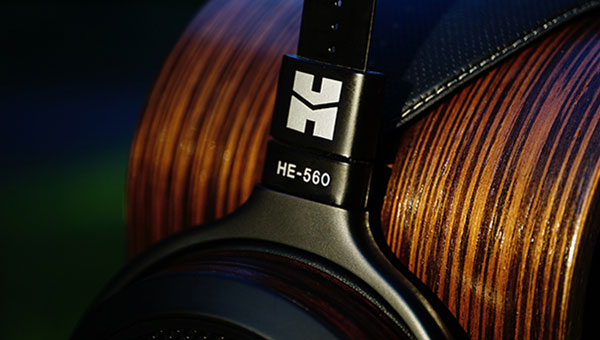Sound Impressions
Summary
My initial expectation of both the HE400i and the HE560 was that of an older brother and cheeky little upstart of sorts. That both would really be the same but maybe the HE400i would be a step down in resolution, extension, and quality.
However in reality, after testing, they are really two different unique headphones with specific niche listeners in mind. Mind you if added mid-bass weight is a good definition of a cheeky upstart then the HE400i may not be that far off my initial pre-review impressions.
Both the He400i and He560 have a far better tonal balance than before. The HE400i stays in much safer or familiar territory than the more airy HE560 in terms of weight and bass tuning whilst the HE560, though lighter in bass slam never sounds too lean, sharp, or bright.
Instead, it trades a bit of the HE400i’s overriding musicality and fun for a better sense of accuracy, a more natural-sounding timbre, and additional reach both in terms of bass extension and treble articulation or headroom.
The HE400i is the warmer of the two headphones with a keener emphasis on bass response combined with a forward midsection and a smooth and slightly laid-back treble performance.
The HE560 on the other hand aims squarely for a more coherent or linear presentation with an emphasis on accuracy and detail. If anything the HE560 could be regarded as being neutral and flatter in overall tonality but not void of musicality or coming across as overly sterile and flat.
Bass
Two different flavors of bass for the HE400i and the HE560 will appeal to quite different audiences depending on how you want the bass to perform.
Unquestionably the HE400i’s bass is the more dominant signature between the two headphones with a much thicker and weighted bass slam and a more pronounced mid-bass hump. Whilst it is not as pronounced as the HE400’s bass response the texture and tonality of the HE400i is a slightly better all-rounder for modern musical tastes.
Pair the HE400i’s bass signature with the likes of Dash Berlin or a Deadmau5 and it has no problem with both the pace and power, sounding convincing and confident without ever being overbearing.
The HE560 on the other hand has a much more linear and neutral bass response that is tighter, more controlled, and perhaps more realistic than the HE400i. It also has greater extension than the more mid-bass orientated HE400i, more in keeping with the type of extension the HE6 has but maybe a little lighter in the body overall.
The HE560 bass response is a lot more transparent and true also to whatever source or recording you are going to be using. The HE560 bass presentation will not overemphasize or add undue coloration so if you want to dial up the bass it might be better to start with the HE400i in the first place otherwise the HE560 stays truer and more accurate.
Midrange
The HE400i midrange is thicker, more forward, and more emphasized than the HE560. However, the HE560 retains a flatter and more coherent or balanced midsection. Both have their plus and minus points.
The coloration and slightly forward and more intimate nature in the HE400i’s mid-range is actually a positive for the character of the HE400i sounding musical without ever being too shouty or messy. They are certainly a much-improved performance over the rather recessed mid-range of the HE400 and convey a better but more intimate vocal stage than before.
The HE560 mid-range, especially moving to the upper mid-range, starts to sound a lot more open if not as forward as the HE400i. Technically it is far more accurate and the detail is a few notches higher.
Initially, it might not seem as musical as the HE400i but the clarity and timbre just feels perfect, especially for strings, acapella, and female vocals. After considerable testing I actually found the mid-range of the HE560 to be more satisfying and absorbing in the long term whilst the HE400i I found to be more capable of impressive blasts over shorter listening periods.
Vocal performance largely mirrors their tonality and midrange performance with the HE400i sounding beefier and more forward but also more forgiving and rarely displaying any signs of sibilance.
The HE560 though is more neutral and slightly more detailed but a little bit thinner meaning it was a bit more prone to displays of sibilance on certain tracks but it also had more articulation and subtly with female vocals, especially operatic vocals that require plenty of space and control to sound convincing.
Treble
The HE560 does treble really right for me. Very few cans can master a treble performance satisfactorily, the HE560 is one of those headphones, along with the Beyer T70p and, when set up right, the HE6.
Whilst the HE6 treble depends on a lot of variables the HE560 delivery articulates clean treble right out of the box with great extension and air, neither being too harsh or strident or too rolled off. It is beautifully balanced and matched on the EF6 which has a liquid-like relaxed signature.
Honestly, it sounded superb. Black Key’s “Strange Times” sounded positively brimming with energy and clarity and not a sibilant peaky note in the house. I am particularly fond of how the HE560 tones down splashy cymbal work without losing any impact and clarity – that lack of tizziness is addictive. It doesn’t quite have the detail of the HD800 treble performance but it is certainly more forgiving and musical.
The HE400i follows a slightly more typical consumer-type treble response than the HE560, being overshadowed by the thicker and weightier bass and midrange presentation.
Compared to the HE560 the HE400i treble is competent and clear but not as detailed or articulate and lacks a considerable amount of air to really extend adding to a more intimate closed-in feel than the more open HE560.
The plus side is the HE400i is that is ‘oh so forgiving’ and smooth and lacks any of that unwanted peaky performance that the later revisions of the HE400 seemed prone to. Lossy recordings will be well treated by the HE400i.
Soundstage
Planars are not universally renowned for big accurate soundstage and imagining at the best of times and the same could be said of both the HE400i and the HE560 with the HE560 sounding wider and taller than the more closed in HE400i.
The HE400i lack of upper extension and more forward bass and midsection comes off as being intimate and tight but never messy or too congested. Image separation is just ok, on par really but not quite on the same level as the more open HE560.
The HE560’s airier and more open presentation delivers a more believable soundstage with a more accurate sense of separation and imaging but it is not a huge soundstage by any means.
Old Versus New
The HE400/400i bass debate
There will be quite a few reading this review clutching to their older HE400, HE500, and maybe even their HE6 wondering if this is the right moment to let go of the old and embrace the new.
Mostly I would say yes totally but there are a number of small caveats when you decide to drop some new notes on these shiny new planars that you should be aware of.
Whilst the He400i is likely to be the most consumer-orientated or bass-tuned Hifiman between the two, perhaps even in the entire updated range (unless Fang surprises us and that’s always possible), it doesn’t quite have the same strength of slam as the older HE400.
I remember a buddy of mine talking when we initially got the rev 1 production HE400 about how the bass on the HE400 was just about the most addictive mid-tier bass response we heard in ages.
Well, the HE400i bass response is still satisfyingly good and perhaps more coherent in its transition to a better and more forward midrange than the HE400 but the HE400 slam still has the edge and the depth.
The edge of course at the cost of an underperforming mid-range but if it is all about slam you have been warned. That being said I do prefer the HE400i’s more textured and detailed bass and its more naturally balanced sound which to me is more convincing as a whole than the HE400’s slightly disjointed overall presentation.
Which is replacing the HE500?
The HE500 along with the HE6 retains a special place in my headphone journey and the HE500 still retains a high degree of musicality, transparency, and smoother delivery to this day.
Comparing the HE500 to the HE400i and HE560 is not an easy task though as neither are direct replacements of this older release. The HE560 is probably the one most people will say is the main replacement and to a certain extent, that is true.
The HE560’s detailed and articulate treble performance easily outshines the HE500 slightly peakier treble response and the balance in the attack and decay are much sweeter than the sometimes tizzy upper treble response of the HE500.
The HE560 midrange, whilst sounding a bit thinner than the HE500 feels a bit more balanced and accurate than the HE500’s midrange. Some might prefer the HE500’s thicker midrange but I felt the vocals didn’t quite stand out as well as the HE560’s performance.
Bass Performance
Perhaps the biggest area of the debate might be the bass performance of the HE500 compared to the HE560 and the HE400i. No question they are different beasts in much the same way the HE400i is to the HE560.
Of all the three the HE400i’s bass performance is going to sound the hardest hitting and musical and probably the most suitable for modern pop and beats genres. The HE560’s bass response is leaner, tighter, and faster with more extension, much more so than the HE500.
Yet the HE500 treads a middle path with a decent dynamic punch and extension that might be a suitable compromise between both the HE400i, which at times can sound much more closed in and less detailed and the HE560’s linear but very controlled bass response.
It really depends on your preference for which one has the right bass for you. If you need control and speed and great extension then pick the HE560. If you want a good extension with a bit more mid-bass slam and weight then the HE500 will still appeal to you. For a far more bass dominant tuning then the HE400i’s high levels of musicality and bass power will be the preferred choice.
Click on page 3 below for pairings and select comparisons





